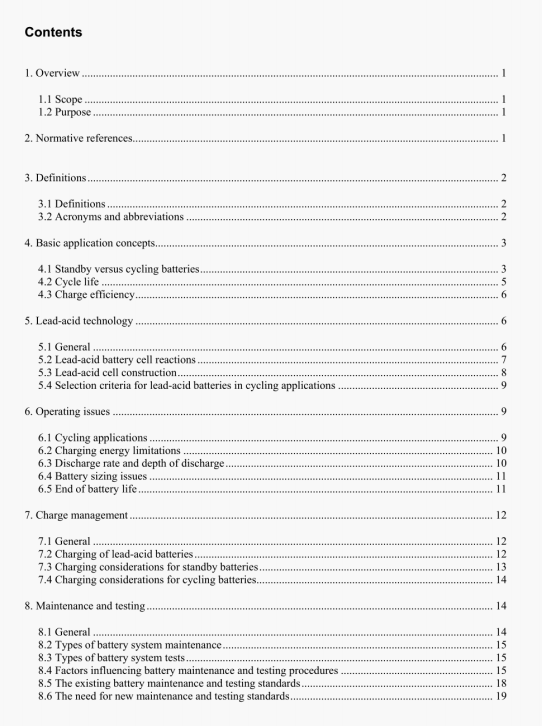IEEE Std 1660:2008 pdf free download.IEEE Guide for Application and Management of Stationary
Batteries Used in Cycling Service.
Design of lead-acid cells for these deep-cycle applications considers the protection and preservation of the active materials during these deep discharges and potentially abusive high-rate recharges.
The design of lead-acid batteries in cycling applications should consider not only the effect of the deep discharge on the active material but also the fact that the battery may be operating at a partial state of charge (PSOC) for prolonged periods.
5.2 Lead-acid battery cell reactions
5.2.1 General
Rckr to Annex B for details of lead-acid electrochemistry.
5.2.2 Discharging
During the discharge process. the sulfuric acid (H2S04) in the electrolyte is consumed, resulting in the ftrmation of lead sulfate in both the positive and negative plates. This leads to a progressive dilution of the acid (Jnder normal circumstances, this process is fully reversible. If a battery is over-discharged, however, the electrolyte may become so dilute that lead sulfate can dissolve. This situation can lead to “hydration shorts” through the separator when the lead sulfate precipitates out of solution upon recharging.
5.2.3 Recharging
During recharge. the lead sulfate from the plates is convefled back to the charged form, and sulfuric acid is replenished. The active materials are normally returned to a fully charged condition once the charging source has restored approximately 102% to 120% of the ampere-hours previously removed, depending on the nature of the discharge and recharge regime.
5.2.4 Gassing
Charging energy that is not stored in the active materials is dissipated by various means. In the vented cell. most of the excess energy results in electrolysis of water to produce a stoichiometric mixture of hydrogen and oxygen. and these gases are released to the atmosphere. Distilled or deionized water should be supplied to make up for the waler consumed. Depending on the positive-plate grid alloy, the charging voltage, and the floatfmnish current, the resulting water loss can be very small.
5.2.5 VRLA gas recombination
In the valve-regulated lead-acid VRLA) cell, the electrolyte is immobilized by either being in a gelled form or being completely absorbed in an absorbed glass mat (AGM) separator between the plates. This facilitates oxygen gas (O) diffusion to the negative plate where the recombination reaction will occur (see B. 1.4). Under perfect conditions, there is no net reaction. That is. there is no water loss or hydrogen gas evolved as a result of the electrolysis of the water at the positive plate. 1-lowever, due to grid corrosion and other processes. the cycle is not l004, efficient and so there will be some water loss and gassing, although ii will only be a fraction of that experienced in a vented cell. Since VRLA cells are typically sealed in terms of electrolyte maintenance, overcharging should be minimized so as not to exceed the recombination capability.
IEEE Std 1660:2008 pdf free download
